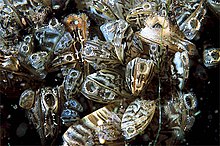Dreissena polymorpha
| Zebra mussel | |
|---|---|
 |
|
| Live zebra mussels underwater with shells open, animals respiring, siphons visible | |
| Scientific classification | |
| Kingdom: | Animalia |
| Phylum: | Mollusca |
| Class: | Bivalvia |
| Order: | Veneroida |
| Family: | Dreissenidae |
| Genus: | Dreissena |
| Species: | D. polymorpha |
| Binomial name | |
|
Dreissena polymorpha (Pallas, 1771) |
|
The zebra mussel (Dreissena polymorpha) is a small freshwater mussel. This species was originally native to the lakes of southern Russia and Ukraine, being first described in 1769 by the German zoologist Peter Simon Pallas in the Ural, Volga, and Dnieper rivers. However, the zebra mussel has been accidentally introduced to numerous other areas, and has become an invasive species in many different countries worldwide. Since the 1980s, they have invaded the Great Lakes and the Hudson River. They are commonly found on the bottom of ships and eat the algae that is food for fish. Without food, fish starve. Inspectors check ships for the mussels before they leave port. Scientists are trying to control the mussels.
Zebra mussels get their name from a striped pattern commonly seen on their shells, though it is not universally present. They are usually about the size of a fingernail, but can grow to a maximum length of nearly 2 in (5.1 cm). Shells are D-shaped, and attached to the substrate with strong byssal threads, which come out of their umbo on the dorsal (hinged) side.
Zebra mussel and the closely related and ecologically similar quagga mussels are filter-feeding organisms. They remove particles from the water column. The zebra mussels process up to one liter of water per day, per mussel. Some particles are consumed as food, and feces are deposited on the lake floor. Nonfood particles are combined with mucus and other matter and deposited on lake floors as pseudofeces. Since the zebra mussel has become established in Lake Erie, water clarity has increased from 6 inches to up to three feet in some areas. This improved water clarity allows sunlight to penetrate deeper, enabling growth of submerged macrophytes. These plants, when decaying, wash up on shorelines, fouling beaches and causing water quality problems.
...
Wikipedia
